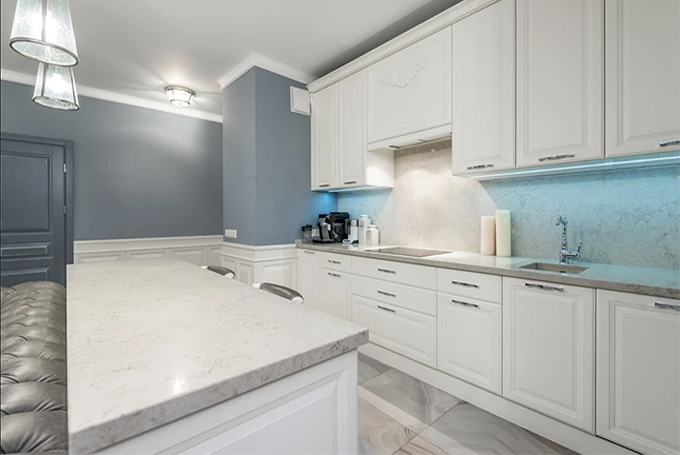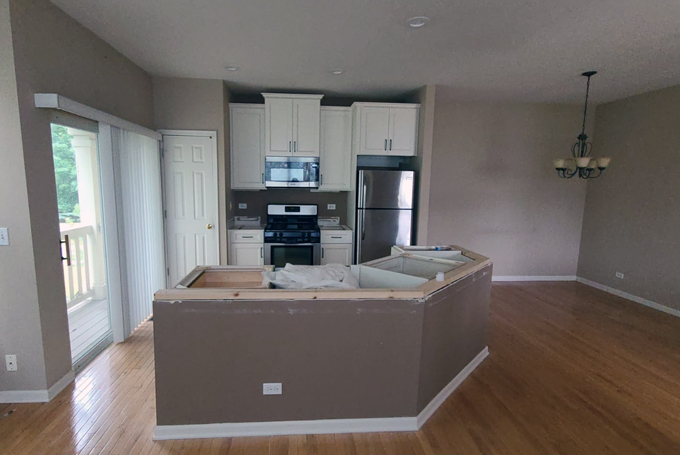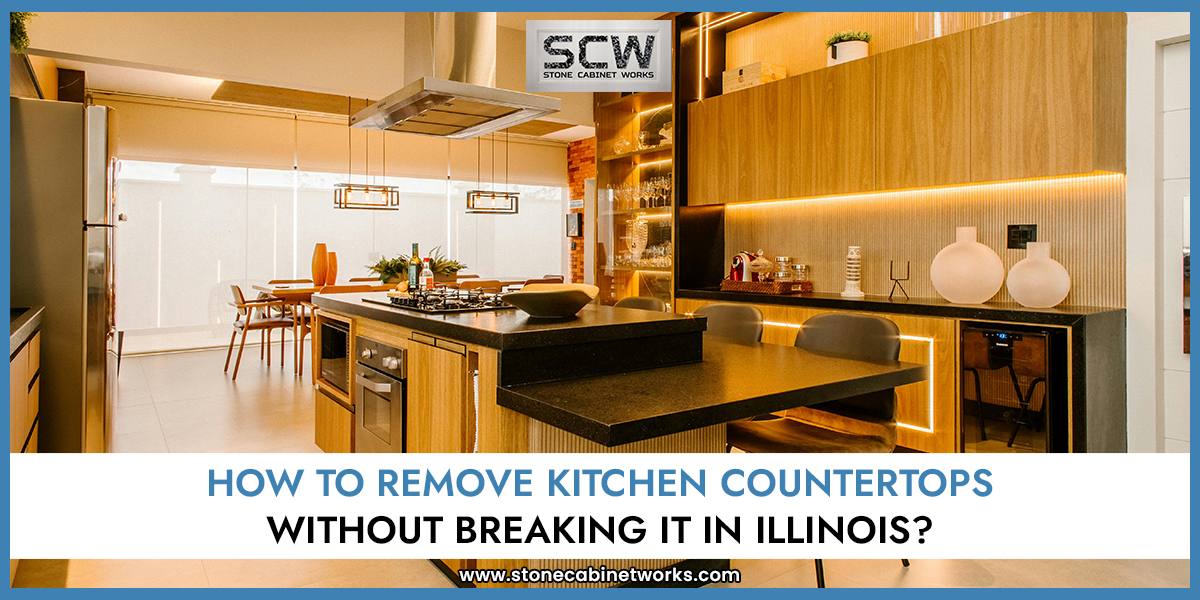Whether you’re renovating your kitchen or just replacing your kitchen countertop to breathe new life into your home, knowing how to remove countertops properly without damaging it can be a daunting task. However, with the right tools, techniques, and a bit of patience, you can successfully remove kitchen countertops in Illinois without breaking it. In this blog, you will explore step-by-step instructions on how to safely remove kitchen countertops.
Step-By-Step Instructions On How To Safely Remove Kitchen Countertops
Step 1: Assess the Situation
Before diving into the removal process, assess which type of countertop you have. Whether it’s laminate, granite, quartz, or another material, understanding the composition will help you determine the best approach for removal.
Step 2: Gather Your Tools and Materials
Before you begin the removal process, the first thing you can do is to gather all the necessary tools and materials to remove countertops without causing damage. These typically include:
- Screwdriver
- Utility knife
- Pry bar
- Hammer
- Gloves
- Safety goggles
- Drop cloths
- Bucket
- Rubber mallet
- Putty knife
- Sealant remover (if applicable)
Step 3: Turn Off Utilities
Before starting any work, it’s essential to turn off the utilities connected to your kitchen, including water, gas, and electricity. This step ensures your safety throughout the process.
Step 4: Clear the Area
Remove all the items from your countertops and clear the surrounding area to prevent damage or obstruction during the removal process. Lay down drop cloths to protect the floor as well as cabinets as this will give you ample space to work and prevent any damage to your belongings during the removal process.

Step 5: Disconnect Sink and Appliances
If your countertops have a built-in sink or appliances, such as a cooktop, disconnect them carefully. Turn off the water supply to the sink and disconnect the plumbing. For appliances, such as a cooktop, turn off the gas supply and disconnect any electrical connections.
Step 6: Remove Fixtures and Trim
Using a screwdriver, remove any fixtures, such as faucets or handles, attached to the countertops. Don’t forget to remove any trim or molding around the edges of the countertops using a utility knife as well as pry bar.
Step 7: Loosen Countertop Seams
If your countertops are made of multiple sections joined together, use a utility knife to cut through any caulk or sealant along the seams, you can also use this technique if your countertops are sealed to the wall or backsplash. This will help you loosen-up the countertop for removal.
Step 8: Start Removing Countertops
Begin by using a pry bar to gently lift the countertops away from the cabinets or use putty knife at one end of the countertop and gently insert a between the countertop as well as the cabinets. Start at one end and work your way across, applying even pressure to avoid damaging the cabinets or walls. Apply gradual pressure to lift the countertop away from the cabinets. Use a rubber mallet to tap gently if needed, but avoid excessive force to prevent damage.
Step 9: Work Carefully While Lifting the Countertop
Continue to work along the length of the countertop, gradually lifting and loosening it from the cabinets. As you lift the countertop, have a helper support it from below to prevent it from breaking under its weight. Use caution, especially with heavier materials like granite or quartz.Take your time and avoid rushing the process to minimize the risk of breakage or injury.
Step 10: Dispose of Countertop
Once the countertops are removed, carefully transport them outside for disposal. Depending on the material, you may need assistance due to their weight. However, be sure to follow local regulations for disposal or recycling.
Step 11: Clean and Prepare Cabinets
Once the countertop is removed, remove any remaining adhesive or debris from the cabinets using a putty knife and cleaning solution. Inspect the cabinets for any damage and make repairs as needed before installing new countertops.

Step 12: Final Preparations
Before installing your new countertops, double-check the measurements and ensure that the cabinets are properly leveled and secure. Make any necessary adjustments to ensure a proper fit.
FAQs:
Q1: Can I remove granite countertop without breaking it?
Ans: Yes, granite countertop can be easily removed without breaking it by following the proper removal techniques outlined in this blog. Take your time, use the right tools, and enlist the help of a friend to support the countertop as you lift it.
Q2: How do I avoid damaging the cabinets during countertop removal?
Ans: To avoid damaging cabinets, use a pry bar or putty knife to gently lift the countertop away from the cabinets, applying even pressure along the length of the countertop. Take care to support the countertop from below as you lift it to prevent bending or breaking.
Q3: What should I do with the old countertops after removal?
Ans: Depending on the material, old countertops can be recycled or disposed according to local regulations. Contact your local waste management facility for guidance on proper disposal methods.
Q4. Can I replace countertops without replacing cabinets?
Ans: Yes, you can replace countertops without replacing cabinets in most cases. Countertops are typically installed separately from cabinets and can be removed without affecting the structural integrity of the cabinets. However, it’s essential to ensure that the cabinets are in good condition and properly leveled before installing new countertops. Additionally, consider the compatibility of the new countertops with the existing cabinets in terms of size, style, and weight. Proper measurements and planning are crucial to ensure a seamless replacement process.
Q5. Can you remove and reinstall quartz countertops without breaking?
Ans: Yes, it is possible to remove and reinstall quartz countertops without breaking them, but it requires careful handling and proper techniques. Quartz countertops are durable but can be prone to cracking or chipping if mishandled during removal.
Q6. How can I remove both kitchen countertop and sink without causing damage?
Ans: To safely remove a kitchen countertop and sink without causing damage, it’s crucial to follow a systematic process. Here’s a detailed guide:
1. Preparation:
- Start by shutting off the water supply valves under the sink.
- Clear out the cabinets below the sink and remove any items on the countertop.
- Gather the necessary tools, including a utility knife, screwdriver, pry bar, drop cloth, and razor knife.
2. Removing the Sink:
- Disconnect the plumbing connections under the sink, including the water supply lines and drain pipes.
- Once the connections are detached, use a utility knife to cut through any caulk or sealant around the edges of the sink.
- Carefully lift the sink out of its position and set it aside.
Q7. How to remove glued down granite countertops?
Ans: Removing glued-down granite countertops requires patience, same steps as mentioned in this blog and the right tools to avoid damaging the countertops or the surrounding area. But if the countertop is particularly stubborn does not lift then you may need to use a heat gun to soften the adhesive before attempting to lift it again. And once it removed, clean any remaining adhesive from the cabinets using a solvent or adhesive remover. After that, inspect the countertops for any damage and make repairs as needed before reinstalling or disposing of them.
Q8: What is the correct method to disconnect a kitchen countertop from the wall?
Ans: To properly remove the kitchen countertop from the wall, it is essential to follow these steps outlined below:
- Use a razor knife to cut through any adhesive or caulk. This will separate the countertop from the wall.
- Position a pry bar between the countertop and the wall. Apply gentle pressure to pry the countertop away from the wall, moving along its length gradually.
- Be cautious not to use excessive force that could damage the wall or countertop.
Conclusion:
Removing kitchen countertops in Illinois without breaking them is a manageable task with the right tools and techniques. By following the steps outlined in this blog and taking precautions to ensure safety, you can successfully remove old countertops and prepare your kitchen for a fresh new look. Remember to work carefully, take your time, and don’t hesitate to seek professional help if needed. With patience and perseverance, you’ll achieve the desired results without any unnecessary damage.


